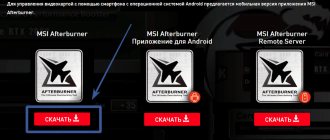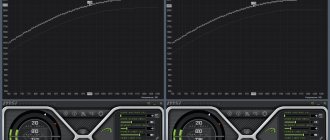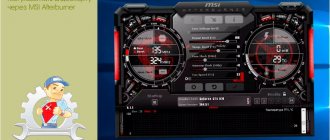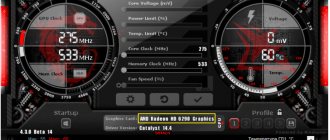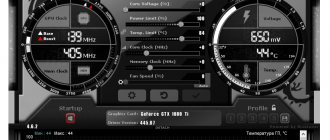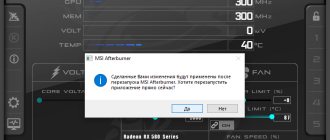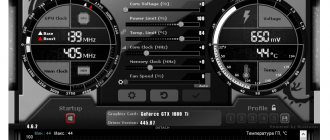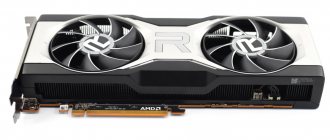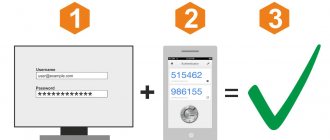Afterburner MSI is a free utility for overclocking a video card and monitoring the temperature and load of the video card and processor. It supports Nvidia and AMD Radeon video cards.
You can download the msi afterburner program in Russian on the official website at: https://download.msi.com/uti_exe/vga/MSIAfterburnerSetup.zip.
During installation, the program will offer to install Riva Tuner Statistics Server along with it. You must agree, because without this some functions will not be available.
The MSI Afterburner start window looks like this:
If you are planning to overclock your video card, remember: you ALWAYS do this at your own peril and risk. Overclocking may well lead to a video card failure, and there are no guarantees that this will not happen. Although, of course, if you do everything carefully and carefully, nothing like this should happen.
First, let's consider the standard situation when the sliders above the buttons do not reach their maximum values (as in the screenshot above). If they do, some additional steps will be required, and more on them later.
How to enable monitoring in MSI Afterburner
Observation tools are represented by graphs in the corresponding panel and an overlay screen display (OED). The second function is partially supported by default, and partially requires the presence of the RivaTuner Statistics Server (RTSS) . Without it, for example, you cannot view FPS in MSI Afterburner. It is installed after installing the program; you can also separately download and deploy the RivaTuner statistics server on your computer.
An overlay display is a modal image located on top of the main one - the game. The overlay and background image are processed and displayed as separate layers and do not affect each other.
- Open Afterburner settings, visit the “Monitoring” tab.
- In the “Active graphs...” section of the “Monitoring” tab, check the boxes: “GPU temperature”, “Frame rate” and other indicators.
- Click on each one and turn on the “Show in OED” function.
Display parameters in overlay.
To the right of the “Show in OED” option, the colors of the inscriptions and methods of displaying indicators (text form, graphic form, both) change.
Video instruction
Our author is overclocking his nVidia GeForce GTX 1050 ti graphics adapter. We recommend watching how he does it and drawing your own conclusions. In the future, the information will definitely be useful to you and the question of how to use MSI Afterburner will become much more clear.
Attention, if you get the error “The application could not start because its parallel configuration is incorrect,” try reinstalling C++ Redistributable.
How to set up MSI Afterburner monitoring
The application allows you to customize the appearance of the EOD in the “Monitoring” tab.
- Sensor polling period – the frequency of receiving information from sensors in milliseconds – and, accordingly, the frequency of updating information on the display.
- Click on the button with three dots to the right of the name of the “Active graphs...” subsection. A list of plugins will open - import additional parameters from other information and diagnostic utilities.
Check the boxes next to the add-ons you need. The information will appear after launching the corresponding programs: AIDA64, CPU-Z, GPU-Z. - Check the box to display the graph in the monitoring window (fixed at the bottom of the program).
- Data source - where MSI Afterburner gets the information to build the graph (internal or external - plugins).
- Chart properties – displayed at the bottom, active after selecting a chart (clicking on it).
More details about the settings. - Number of columns with graphs.
Two columns of graphs. - Below are the properties of the current chart (which is under the cursor).
Graph properties
- Displays on an on-screen overlay display indicating the color of the item and how the option is displayed.
- Display information on the display built into the Logitech keyboard.
- Adding an icon to the tray, choosing its color and visualization method.
- Alarm when the value goes beyond the specified range - a yellow triangle will appear in the monitoring window with information that the indicator has gone beyond the established limits.
To notify the user, MSI Afterburner can launch applications, for example, a music player, can automatically end the game, turn off the computer, and play a sound file.
Alert output options.
- The chart limits are indicated below - the option allows you to cut off peak and (or) minimum values in order to focus on the dynamics of the desired indicators.
- Redefining the name (renaming) of a chart or their group.
- Color of the graph in multilayer mode.
Names and colors change. - The correction formula will change the value by the specified amount. For example, the initial temperature of the GPU is 23° C. If you enter -23 in the text form, the graph will display the heating of the device - the difference between the initial and current temperatures.
- Report properties – subsection for activating and configuring monitoring logging, viewing ready-made reports. They will help in identifying problems in the operation of hardware components, possibly arising as a result of increasing the performance of the video card.
- Below – key combinations for managing reports are set.
Unimportant settings.
Efficient cooling
To activate manual variable change, click on the gear icon next to the Fan Speed slider.
Rice. 17 – Enabling manual cooler speed control mode
If you want the system to independently adjust the fan speed based on the current temperature of the video card, switch to automatic value control by clicking on the Auto icon.
Rice. 18 – Activate automatic fan speed control
In the “Cooler” settings section, you can specify the update frequency of the parameter and achieve maximum cooling efficiency, minimizing fan rattling.
Rice. 19 – Changing the period for updating data on the current fan speed
How to enable FPS in MSI Afterburner
It is important for gamers to see not only the temperature, load and frequencies of computer components during gaming press, but also to monitor the FPS. This is the most important indicator for comfortable gameplay. The more FPS the video card generates, the smoother and more pleasant the picture.
To enable FPS display over games:
- Visit the “Monitoring” tab in the program settings.
- Activate the “Frame Rate” option – check the box in front of the name.
- Change the values of the remaining parameters to suit your needs (described above) and save the configuration.
Activation and setting of frame rate.
Setting up hotkeys for OED in MSI Afterburner
We activated the on-screen display in the overlay and it appeared. How can I turn off this EOD? Hot keys.
- Open MSI Afterburner Settings and visit the OED tab.
- Click on the “Show OED” field and hold down the key combination to enable the overlay with Alt, Ctrl or Shift, which is not used in Windows and other applications.
- Repeat the same to disable monitoring.
Assigning keyboard shortcuts to control the overlay. - Save your settings.
Programming buttons to display and disable EOD in games is not necessary, but soon after using the function, assigning operations to a global key combination will be required.
Important. The first line “Toggle OED visibility” replaces the next two. One click will turn off monitoring in MSI Afterburner (if enabled), and display it on the display if disabled.
Enabling overlay in MSI Afterburner (OED)
To visualize and disable selected indicators over the game, hold down the previously programmed buttons.
- If nothing appears, or MSI Afterburner has stopped showing monitoring in games, click “Advanced...” in the “OED” tab to call the statistics server.
Opens a window with additional options. - Activate the “Show On-Screen Display” option.
- Then enable "On-Screen Display Support".
Overlay configuration.
In the window you can configure the appearance of the overlay: color, font, size, shadow, display mode.
If the OED does not appear:
- Close the game and launch RivaTuner Statistics Server.
- Click “Add”, select the game executable file, click “Open”.
Adding individual settings for each application.
For each game you can change the appearance of the OED.
Core Clock
It’s worth starting with this slider, GPU frequency. First move it to the right by about 40-50 MHz and click the "Apply" button:
Its current frequency will be marked on the left circle. Now you need to test your video card using any graphics testing program. FurMark or 3DMark are good options.
You need to ensure that, firstly, the temperature does not rise above 90 degrees, and secondly, that no graphic artifacts appear on the screen: stripes, some non-displayable areas of the screen, color glitches, in general, anything strange and unusual .
Then you can further test the resulting frequency by launching any demanding game and playing it for about an hour to be sure. The temperature can be displayed in a background transparent window using Afterburner MSI itself; these settings will be discussed at the end of the article.
Automatic overclocking of a video card is a bad idea; we will overclock it manually, which will give us greater overclocking potential. If everything works well without glitches and overheating, you need to move this slider to the right again and test it again. The further you go, the smaller the step it is better to take. For example, it’s no longer 40, but 20. And this needs to be done until the limit is found at which glitches will appear. Reduce the frequency from the found limit by 10-15 MHz and retest again, just in case. Everything should work. If so, you can move on to the next point.
How to enable Frametime graph in monitoring?
FPS – frame rate displayed per second. Frametime – distribution of these frames in time. Out of 30 FPS, 10 frames can be generated in the first half second, and 20 FPS in the second. Uniform drawing intervals are important for gamers. In cases of greater distortion, microfreezes appear and shaking is noticeable.
In the summer of 2022, MSI Afterburner 4.4.0 was released with a new feature for displaying Frametime or Frame Time on the graph.
Enable frametime in MSI Afterburner in the settings:
- Click on the gear and activate the “Monitoring” tab.
- Among the graphs, activate “Frame time” - put a tick in front of the name.
- Click on the option name, then “Show in OED”.
- Select the visualization method “Graph” or “Text, graph”.
- Apply the settings.
Algorithm for activating frame time display.
Cooler
To change the cooler settings, you need to click on the “Settings” button, go to the “Cooler” tab and check the “Enable software user auto mode” checkbox there.
A graph of the dependence of the cooler rotation speed on the video card temperature will appear below. It can be changed manually by moving the gray squares. There is no need to set the maximum speed to any temperature, because this will quickly damage the cooler. By combining these settings with the ones above, you can achieve optimal overclocking of your video card.
Setting up saving game screenshots and video capture
The screenshot saving and video capturing features of MSI Afterburner are rarely used. First you need to set the keys for taking screenshots, starting and stopping screen video recording.
- In the settings, click on the text field and hold down the keys to take a screenshot.
- Select the format (optimally jpg) and picture quality.
- Directory for saving graphic files.
Configuring screenshots in MSI Afterburner. - Save your settings.
During the game, press the indicated button or combination to take screenshots.
Setting up game video recording
- Visit the Video Capture tab.
- Click on the first text field and set a key or combination to record a game video.
Video capture options. - Specify other recording parameters: mode - desktop or 3D application (game), video format, container, quality, frame rate, output directory, and others.
About the program
A stable and reliable assistant for gamers, overclockers, and miners, capable of taking discrete graphics performance to a new level. Gives access to monitoring the performance characteristics of the graphics accelerator in real time. Creates graphs of two dozen indicators, including temperature, frequencies, and load on video card components.
Read about video card overclocking parameters at this link.
The appearance of windows changes thanks to design themes. The updated engine made it possible to reduce their size and speed up the drawing of the interface. With RivaTuner istic Server (RTSS) it will record video from the screen to a file and display the frame rate (FPS) in the game. MSI Afterburner stores up to five overclocking profiles and supports hotkey management. Can automatically start with Windows. To autostart, click on the “Startup” icon.
Button to autorun the program along with Windows.
How to use monitoring in games
To prevent overheating, be sure to turn on the alarm when the temperature sensor reaches 80-85°C. To avoid missing the moment of overheating, activate the sound function as a warning.
Enables an alarm to prevent thermal damage to the video adapter.
In addition to temperature, pay attention to FPS - a drop below 24 frames will lead to jerky image playback. The situation is possible if the graphics accelerator cannot cope with the load when the video card is very hot. In the latter case, it resets frequencies for cooling. When the device regularly or quickly heats up above 80-85° C, games crash, you should think about reducing the operating frequencies by several percent. If you increased the video core voltage, reset it.
It happens that MSI Afterburner stops displaying EDS in Counter-Strike: Global Offensive (CS: GO). It helps to launch the game through the launcher with the parameters “-allow_third_party_software”. Try updating Afterburner. Read more about solving problems with monitoring by following the link.
How to turn off monitoring in Afterburner
- The display of unnecessary indicators in the monitoring settings is disabled: click on the parameter, uncheck the “Show in OED” checkbox and apply the changes.
Algorithm for disabling one or more indicators. - All parameters will be removed from the screen by the combination of hot keys specified in the OED tab.
The first combination alternately shows and hides, the third only hides.
Second option to turn off monitoring
Move the RTSS “Show On-Screen Display” switch to the “OFF” position.
Hide the panel using Statistics Server.
Questions and answers
We will help you solve any problem with Afterburner.
Is it possible to customize the monitoring position on the game screen?
Launch RTSS, select a profile (global or specific game), on the screen at the bottom right, place the element in the desired place using the mouse. Use the arrow buttons to precisely position the overlay. The On-Screen Display zoom switch changes the scale of the overlay.
Overlay position control.
